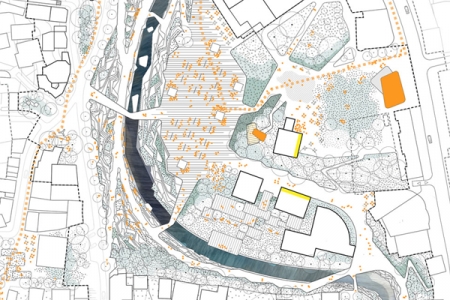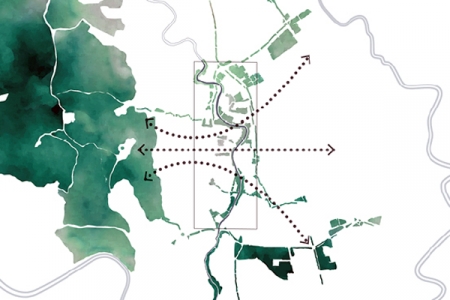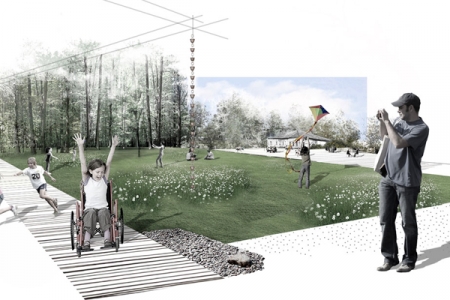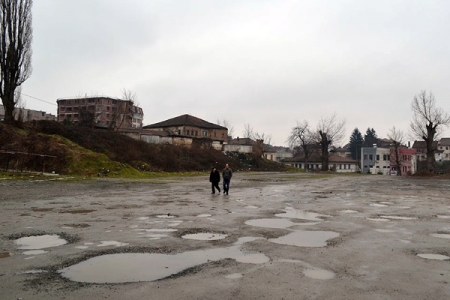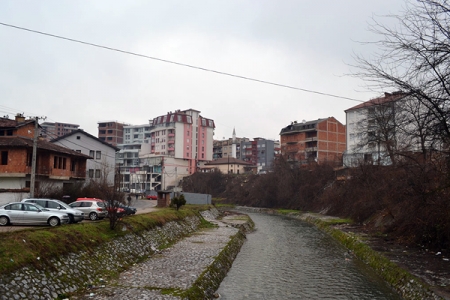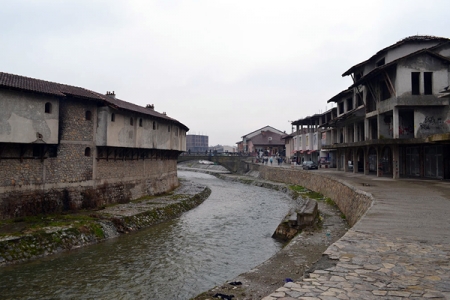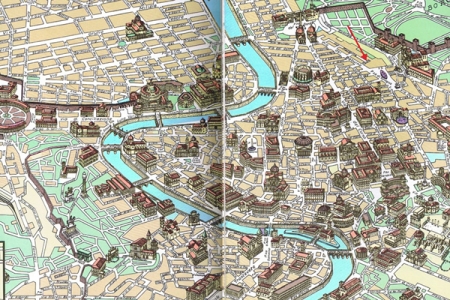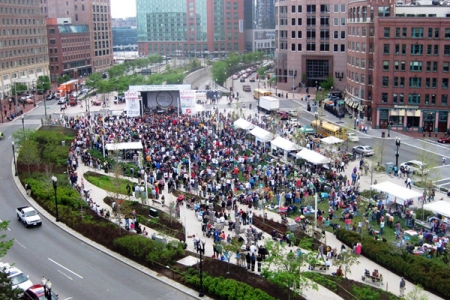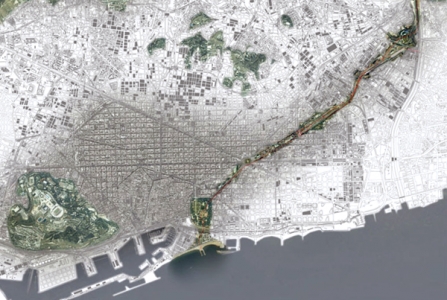SEAMbiosis
Gjakova (KO) – Lauréat
DONNÉES DE L’ÉQUIPE
Représentant d’équipe : Erblin Bucaliu (KO) – architecte ; Associés : Rrita Pula (KO), Dea Luma (KO) – architectes
Kompleks Avalla, B1, nr.13, 10000 Pristina – Kosovo
+386 49 178 567 – erblinbucaliu@gmail.com
Voir la liste complète des portraits ici
Voir la page du site ici

D. Luma, E. Bucaliu & Rr. Pula
INTERVIEW en anglais
Cliquer sur les images pour les agrandir
1. How did you form the team for the competition?
Team Bucaliu-Luma-Pula is a merger of 25-26 year young architecture designers with a sparkle of interests in landscape, urbanism, and public space. Born and raised in Prishtina (KO), we each had opportunities to live and come in contact with multiple cultures such as Boston (US), Berlin (DE) –E. Bucaliu–, and Krakow (PL) –Rr. Pula & D. Luma. Blending knowledge from our previous experiences, both academically and professionally, has given us the chance to compare and combine our interests into an effective urban vision for the city of Gjakova.
2. How do you define the main issue of your project, and how did you answer on this session main topic: Adaptability through Self-Organization, Sharing and/or Project (Process)?
The Krena River, though currently neglected, has the potential to play an essential role in Gjakova’s self-sustaining and continually improving cycle of exchanges that creates value. The river and spaces along can be integrated into a coherent urban framework that preserves the sense of community and facilitates interaction due to its central location in relation to city’s urban fabric.
“SEAMbiosis” is an urban investigation involving a complex set of socially, culturally and economically charged issues. It extends the role of architects and the profession to significant contributors in improving living standards of the modern day society by considering our current demands. As a result, the proposal is innovatively articulated as an integrated system of spatial agency – redefining the methods, instruments, and approaches of the profession of Architecture as the means for social transformation.
Enhanced accessible spaces along the river stitch the historic town with the modern city to bring a new perspective to a familiar context. A city once divided into two sides by a river becomes a compact and diverse entity; one that promotes the city’s cultural heritage, public places, and gives rise to a complex decentralized network of spaces and city’s landmarks and monuments. In essence the river becomes the technology and medium for proper communication within the city of Gjakova.
3. How did this issue and the questions raised by the site mutation meet?
Our proposal is firmly encompassed at the seam between architecture, urban design and landscape architecture as instruments to improve the individual and collective experience in the city of Gjakova. The role of the river is transformed into a unifying element within the city’s landscapes and urban fabric with a great potential to also be woven into people’s lives.
The definition of space is ethically manipulated by carefully crafting the physical city in such a way that results in freedom of movement and convenient access to all the good things Gjakova has to offer. The generated open spaces along the river function as catalysts for social activities and community engagement, while mediating and reconciling the site with its context.
4. Have you treated this issue previously? What were the reference projects that inspired yours?
The ability to analyze and synthesize the research findings of our individual academic theses served as a strong foundation onto which “SEAMbiosis” is constructed.
Europan13 presented the ideal window of opportunity for us to examine innovative design strategies that resonate with the natural, cultural and political rhythms of a place – specifically in the context of Gjakova on “how to transform physical obstacles (the Krena River) into new connections?”. Many European cities are good references on the central role rivers have historically connected, rather than divided, two sides of urban areas. Bold contemporary examples of turning obstacles into connections are the “Rose Kennedy Greenway” in Boston (US) –built– and “Sagrera Linear Park” West-8’s proposal in Barcelona (ES) –un-built. With the highway to be located underground, they both improve the pedestrian experience by creating linear series of parks and gardens that would re-connect some of the oldest, most diverse, and vibrant neighborhoods in each city.
5. Today –at the era of economic crisis and sustainability– the urban-architectural project should reconsider its production method in time; how did you integrate this issue in your project?
Urban and landscape studies are essential tools to better understand and solve problems caused by social, economical and territorial transformations.
The proposed diversity of spaces and flexibility of activities along the Krena River provide the infrastructure for an adaptable and comprehensive city; one that advocates development of a comfortable and active built environment with a common purpose while ensuring social stability.
Existing diversity of functional typologies merges at the site of intervention and forms the basis for the city’s self-sustainable industry, economy and tourism. Integration of the river and spaces along as part of the city’s nucleus presents a passageway that encourages consolidated and interdependent range of functional assortment. The site of intervention provides complementary functions by reactivating neglected buildings/spaces into uses that promote youth engagement and a new re-attachment with the city.
6. Is it the first time you have been awarded a prize at Europan? How could this help you in your professional career?
Europan13 is the first time we have collaborated as a team and participated in such an internationally renowned competition. We are thrilled to have been selected among the E13 winning teams, also considering the fact that we are the first team from Kosovo to have ever won Europan. We are exited to continue the dialogue with the Municipality of Gjakova and contribute to the future development of the city.
Together and separately, we consider this as a milestone in our young careers as architecture professionals. At the same time we look forward to carrying on our aim to grow into a world-class architecture designers, scholars and researchers of the next generation.
